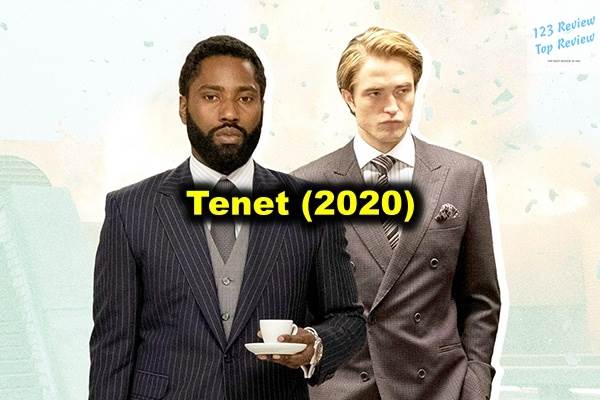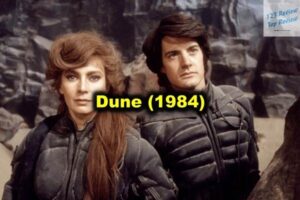Released in 2020, “Tenet” became one of the most talked-about films of the year, not just for its visual spectacle but for the intricate web of ideas it presents.
In this article, 123 Review delves into the many layers of “Tenet,” offering an in-depth exploration of its themes, characters, cinematic techniques, critical reception, plot complexity, and its impact on the science fiction genre.
Analysis of Tenet’s Themes
Exploration of Time and Inversion
Time is the central theme of “Tenet,” not merely a background element but the very axis around which the entire narrative revolves. In traditional storytelling, time is a linear progression—a past leading to the present and then the future. However, in “Tenet,” Nolan challenges this concept by introducing the idea of inversion, where time can be reversed, allowing characters to move backward through events.

This inversion is not simply a gimmick but a profound exploration of how time governs our lives. The film asks the audience to reconsider their understanding of time, urging them to imagine a world where cause and effect can be manipulated, where the future can influence the past. The idea of inversion is intricately woven into the narrative, affecting everything from character motivations to plot development. For instance, the concept of moving backward through time allows for scenes where characters are simultaneously aware of events that have happened and those that are yet to occur, creating a unique narrative tension.
Philosophical Underpinnings: Determinism and Reality
“Tenet” is deeply rooted in philosophical questions, particularly those concerning determinism and the nature of reality. Determinism—the idea that all events are predetermined and inevitable—plays a crucial role in the film. The characters in “Tenet” operate in a world where the future is as fixed as the past, yet they are compelled to act as if they have free will. This paradox raises essential questions about the nature of reality and whether our choices genuinely matter.
Nolan uses the concept of inversion to explore these ideas further. If time can be reversed, does this mean that events are unchangeable, or is there room for deviation? The film’s narrative structure, where events unfold in both forward and reverse motion, symbolizes the tension between determinism and free will. The characters’ actions are predicated on the belief that they can change the future, yet they are constantly confronted with the possibility that everything is already set in stone.
This philosophical exploration extends to the film’s depiction of reality. In a world where time can be inverted, the line between what is real and what is imagined becomes blurred. The characters, and by extension the audience, are left questioning the very fabric of reality. Is reality something we can shape through our actions, or are we merely passengers in a preordained journey?
Moral Implications of the Characters’ Actions
The moral landscape of “Tenet” is as complex as its narrative. The characters are constantly faced with decisions that carry significant moral weight, particularly in a world where time itself can be manipulated. The film explores the ethical implications of these decisions, particularly in the context of a world where the past, present, and future are interconnected.
The Protagonist, for instance, is thrust into a situation where he must make decisions that will affect not just his life but the entire world. His journey is one of moral discovery, as he grapples with the consequences of his actions in a world where the lines between right and wrong are constantly shifting. The film poses difficult questions about the ethics of using time inversion as a tool for achieving one’s goals. Is it justifiable to manipulate time to prevent a catastrophe, even if it means altering the natural course of events?
This moral ambiguity is further explored through the character of Sator, the film’s antagonist. Sator’s actions, driven by a desire for control and power, represent the darker side of time manipulation. He seeks to use inversion to impose his will on the world, regardless of the consequences. His character challenges the audience to consider the moral limits of such power. Where should the line be drawn when it comes to altering the fabric of time and reality?
Character Analysis in Tenet
The Protagonist: Role and Development
The Protagonist, portrayed by John David Washington, is the central figure through which the audience experiences the story of “Tenet.” Unlike traditional heroes who embark on a journey of self-discovery, the Protagonist’s role is both complex and enigmatic. His development is intricately tied to the film’s themes of time, determinism, and morality.
At the beginning of the film, the Protagonist is a skilled operative, committed to his mission but unaware of the broader implications of his actions. As the story unfolds, he becomes increasingly aware of the significance of time inversion and its impact on his mission. His evolution from a soldier following orders to a man who understands his role in a larger cosmic struggle is central to the narrative. This journey is marked by a growing realization of his place in the timeline—an understanding that he is not merely a participant in events but a key player in shaping them.
The Protagonist’s relationship with time is pivotal to his character development. As he learns to navigate the complexities of inversion, he begins to understand the true nature of his mission and his identity. His journey is not just about stopping a global catastrophe but about coming to terms with his role in a world where the future can dictate the past. This realization forces him to grapple with questions of agency and control, making his character arc one of the most compelling aspects of the film.
Neil: The Charismatic Ally
Neil, portrayed by Robert Pattinson, is one of the most intriguing characters in “Tenet.” He serves as both an ally and a mentor to the Protagonist, guiding him through the complexities of time inversion. Neil’s role is crucial to the narrative, as he provides the Protagonist with the knowledge and support needed to navigate the film’s intricate plot.
From the outset, Neil’s charismatic and easygoing demeanor contrasts with the Protagonist’s more serious and mission-driven personality. This dynamic creates a compelling partnership that is central to the film’s emotional core. Neil’s deep understanding of inversion and his seemingly unshakable confidence in the mission hint at a character who is more than he appears.
As the story progresses, Neil’s true importance becomes apparent. His intimate knowledge of the events that unfold, and his willingness to sacrifice himself for the greater good, reveal a character who is deeply committed to the cause. The revelation of Neil’s true identity and his connection to the Protagonist adds an emotional weight to the film’s climax, leaving the audience with a sense of loss and inevitability. Neil’s character is a testament to the film’s themes of fate and sacrifice, making him one of the most memorable figures in “Tenet.”
Kat: Emotional Core of the Narrative
Kat, played by Elizabeth Debicki, is the emotional anchor of “Tenet.” Her character provides the film with its human element, grounding the high-concept narrative in a story of personal struggle and resilience. Kat’s journey is one of liberation, as she seeks to free herself and her son from the control of her abusive husband, Sator.
Kat’s relationship with Sator is a microcosm of the larger themes of control and power that permeate the film. She is trapped in a situation where her autonomy is stripped away, and her every move is dictated by Sator’s whims. This dynamic mirrors the broader narrative, where characters are caught in the web of time, their actions seemingly predetermined by forces beyond their control.
Throughout the film, Kat’s character evolves from a victim to an empowered individual who takes control of her destiny. Her decision to confront Sator and ultimately play a crucial role in his downfall is a pivotal moment in the narrative. This transformation is not just about reclaiming her freedom but about asserting her agency in a world where the future seems as unchangeable as the past. Kat’s emotional journey adds depth to the film, providing a counterbalance to the Protagonist’s more cerebral mission.
Sator: The Complex Antagonist
Sator, portrayed by Kenneth Branagh, is the film’s antagonist, a man whose desire for control and domination drives the plot of “Tenet.” Sator is a complex character, motivated by a deep-seated nihilism and a desire to impose his will on the world. His character is a study in power and the corrupting influence of absolute control.
Sator’s relationship with time inversion is one of domination. Unlike the Protagonist, who seeks to understand and navigate the complexities of time, Sator views inversion as a tool to be exploited for his own ends. His ultimate goal is to use time inversion to bring about the end of the world, an act of ultimate control that reflects his nihilistic worldview.
What makes Sator a compelling antagonist is the depth of his character. He is not simply a villain driven by greed or a thirst for power; his motivations are rooted in a profound sense of despair. Sator’s belief that the world is doomed leads him to embrace destruction as a form of liberation. This complex psychological profile makes him a formidable opponent for the Protagonist and adds layers to the film’s exploration of morality and ethics.
Cinematic Techniques and Craftsmanship
Visual Effects and Practical Effects
“Tenet” is a visual tour de force, a film that pushes the boundaries of what is possible with both practical and visual effects. Christopher Nolan is known for his preference for practical effects, and “Tenet” is no exception. The film combines cutting-edge visual effects with practical effects to create a seamless and immersive experience that enhances the story rather than overwhelming it.
One of the most striking aspects of “Tenet” is its use of inversion in action sequences. These scenes, where time appears to move backward, are executed with a level of precision that is nothing short of astonishing. Nolan and his team achieved this by shooting scenes in both forward and reverse motion, combining the footage to create the illusion of time inversion. This meticulous approach required not only technical expertise but also a deep understanding of the physics of motion, as the actors and crew had to perform actions in reverse to achieve the desired effect.
The film’s use of practical effects also stands out, particularly in scenes involving large-scale set pieces. The sequence where a real 747 plane crashes into a building is a prime example of Nolan’s commitment to practical effects. By using a real plane and minimizing CGI, Nolan creates a sense of realism that grounds the film’s more fantastical elements. This blend of practical and visual effects is a hallmark of Nolan’s filmmaking style and is used to great effect in “Tenet.”
Sound Design and Music Score
Sound design and music are integral to the experience of “Tenet,” contributing to the film’s tension and atmosphere. The film’s sound design is characterized by its use of reversed audio effects, which mirror the theme of inversion. These effects create a disorienting and unsettling atmosphere, drawing the audience into the film’s unique world where time can flow in both directions.
Ludwig Göransson’s score for “Tenet” is another highlight, blending electronic elements with orchestral arrangements to create a soundscape that is both futuristic and timeless. The score’s rhythmic patterns and pulsating beats mirror the film’s temporal shifts, reinforcing the narrative’s focus on time and movement. Göransson’s music is not just a background element but a driving force in the film, propelling the action forward and heightening the emotional stakes.
The combination of sound design and score in “Tenet” creates a sensory experience that complements the film’s visual elements. The use of sound to convey the themes of inversion and time manipulation is a testament to the craftsmanship that went into the film’s production. It’s a reminder of how sound can be used not just to enhance a film’s atmosphere but to deepen the audience’s understanding of its themes.
Cinematography and Action Choreography
The cinematography in “Tenet,” helmed by Hoyte van Hoytema, is nothing short of breathtaking. The film’s visual style is characterized by its use of bold, dynamic shots that capture the grandeur of its set pieces while also conveying the intricacies of its narrative. Van Hoytema’s use of IMAX cameras and large-format film adds a sense of scale to the film, immersing the audience in its world.
One of the standout aspects of the cinematography is the way it handles the film’s action sequences. The choreography of these scenes is meticulously planned to accommodate the concept of inversion. For example, in the sequence where the Protagonist fights a masked opponent who is moving backward through time, the choreography is designed to make the movements appear natural in both forward and reverse motion. This required extensive planning and coordination between the stunt team, the actors, and the camera crew.
The cinematography also plays a crucial role in conveying the film’s themes. The use of light and shadow, the framing of shots, and the movement of the camera all contribute to the sense of disorientation and tension that permeates the film. Van Hoytema’s work on “Tenet” is a masterclass in how cinematography can be used to enhance storytelling, creating a visual experience that is as complex and layered as the narrative itself.
Critical Reception of Tenet
Reviews from Film Critics
“Tenet” received a wide range of reviews from film critics, reflecting its ambitious nature and the challenges it poses to audiences. Many critics praised the film for its originality, visual spectacle, and the sheer audacity of its narrative. However, others found the film’s complexity and dense plotting to be a hindrance, making it difficult to follow and fully appreciate.
On the positive side, critics lauded “Tenet” for its innovative approach to storytelling and its technical achievements. The film’s exploration of time and inversion was seen as a bold move that pushed the boundaries of what cinema could achieve. Nolan’s direction, combined with the performances of the cast, particularly John David Washington and Robert Pattinson, received high marks. The film was also praised for its action sequences, which were described as some of the most thrilling and visually stunning in recent memory.
However, not all reviews were glowing. Some critics felt that “Tenet” was overly complicated, with a plot that was difficult to decipher on a first viewing. The film’s reliance on exposition and its sometimes murky dialogue were cited as drawbacks, making it hard for some viewers to engage with the story. Additionally, the film’s emphasis on concept over character was seen by some as a weakness, with the emotional core of the narrative being overshadowed by the intricate plotting.
Despite these mixed reviews, “Tenet” was widely recognized as a significant cinematic achievement. Even those who were critical of the film’s narrative complexity acknowledged its technical brilliance and its contribution to the evolution of the sci-fi genre.
Audience Reactions and Interpretations
Audience reactions to “Tenet” were as varied as those of critics, with some viewers hailing it as a masterpiece and others finding it frustratingly opaque. The film’s complexity, combined with its dense dialogue and fast-paced action, left many viewers feeling the need for multiple viewings to fully grasp the plot.
For those who embraced “Tenet,” the film was a thrilling puzzle, a cinematic challenge that rewarded careful attention and analysis. The intricate plot, with its time loops and inversion mechanics, was seen as a high point, offering a unique viewing experience that differed from more conventional narratives. Fans of Nolan’s work were particularly enthusiastic, praising the film as a continuation of his exploration of complex themes and non-linear storytelling.
On the other hand, some viewers found “Tenet” to be confusing and impenetrable. The film’s rapid-fire exposition and the density of its plot were seen as barriers to enjoyment, with some audience members feeling overwhelmed by the sheer volume of information presented. The sound mix, which made dialogue difficult to hear in certain scenes, also contributed to the sense of frustration for some viewers.
Despite these challenges, “Tenet” has developed a dedicated fan base, with many viewers returning to the film for repeat viewings in an attempt to unravel its mysteries. The film’s complexity and the richness of its themes have made it a subject of ongoing discussion and analysis, cementing its status as a film that, while divisive, is undeniably impactful.
Awards and Nominations Analysis
“Tenet” received several awards and nominations, particularly in categories related to its technical achievements. The film was recognized for its visual effects, sound design, and production design, all of which were central to its success as a cinematic spectacle.
At the 93rd Academy Awards, “Tenet” won the Oscar for Best Visual Effects, a testament to the film’s groundbreaking use of practical and digital effects to create its unique portrayal of time inversion. The film was also nominated for Best Production Design, highlighting the intricate and detailed sets that played a crucial role in bringing the world of “Tenet” to life.
In addition to its Oscar win, “Tenet” received numerous nominations from other award bodies, including the BAFTAs and the Critics’ Choice Awards. The film’s score, composed by Ludwig Göransson, was particularly celebrated, earning nominations for Best Original Score and winning several awards in this category.
While “Tenet” did not receive as many major awards as some of Nolan’s previous films, its recognition in technical categories underscores its significance as a work of cinematic craftsmanship. The film’s innovative approach to visual storytelling and its technical prowess were widely acknowledged, even by those who found the narrative challenging.
Understanding the Plot Complexity
Key Plot Points and Twists
The plot of “Tenet” is a labyrinthine puzzle, with key points and twists that challenge the audience to think beyond traditional narrative structures. The film follows the Protagonist as he becomes embroiled in a global conflict involving time inversion, a technology that allows objects and people to move backward through time.
One of the central twists in “Tenet” is the revelation that the Protagonist’s mission is part of a larger temporal pincer movement, a strategy that involves coordinating actions in both forward and reverse time. This concept is introduced gradually, with the true nature of the mission becoming clear only in the film’s later stages. The use of the temporal pincer movement adds a layer of complexity to the narrative, as characters must navigate events that are unfolding in both directions simultaneously.
Another significant twist is the identity of Neil and his relationship with the Protagonist. The film hints at Neil’s deeper connection to the Protagonist throughout, but it is only in the final act that the full extent of their relationship is revealed. This twist adds an emotional dimension to the film’s conclusion, as it suggests that Neil’s actions were motivated by a deep personal connection to the Protagonist.
The Temporal Pincer Movement Explained
The temporal pincer movement is one of the most innovative concepts in “Tenet,” serving as both a plot device and a thematic metaphor. In a temporal pincer, two groups operate in different directions through time—one moving forward and the other backward—allowing them to converge on a target from both the past and the future.
This strategy is used in several key scenes, most notably in the climactic battle where the Protagonist and Neil lead a coordinated assault on Sator’s forces. The sequence is a masterclass in nonlinear storytelling, as events unfold simultaneously in forward and reverse motion. The temporal pincer movement not only serves as a tactical advantage in the film’s universe but also underscores the film’s exploration of time as a malleable and multifaceted concept.
The idea of the temporal pincer movement is also symbolic of the film’s broader themes. It represents the idea that time is not a fixed, linear progression but a dynamic force that can be manipulated and controlled. The Protagonist’s mastery of this concept is crucial to his success, as it allows him to navigate the film’s complex temporal landscape and ultimately achieve his goal.
Connections to Other Nolan Films
“Tenet” is often seen as a culmination of the themes and ideas that Christopher Nolan has explored throughout his career. The film’s focus on time, memory, and reality echoes themes found in Nolan’s earlier works, such as “Memento,” “Inception,” and “Interstellar.”
Like “Memento,” “Tenet” plays with the concept of time, presenting a narrative that unfolds in a non-linear fashion. Both films challenge the audience to piece together the story from fragmented and disjointed information, creating a viewing experience that is as much about solving a puzzle as it is about following a plot.
“Inception” shares with “Tenet” a focus on the nature of reality and the power of the mind to shape experience. Both films feature protagonists who must navigate complex, multi-layered realities, with time playing a central role in their journeys. The idea of using advanced technology to manipulate reality is a common thread in both films, as is the exploration of the consequences of such manipulation.
“Interstellar,” with its focus on the relationship between time and human emotion, also bears similarities to “Tenet.” Both films explore the idea that time is not just a physical dimension but a deeply personal and emotional experience. The connection between time and love, a central theme in “Interstellar,” is echoed in “Tenet” through the Protagonist’s relationships with Neil and Kat.
Impact of Tenet on the Sci-Fi Genre
Influence on Future Sci-Fi Films
“Tenet” is poised to have a lasting impact on the science fiction genre, particularly in its innovative use of time as a narrative device. The film’s exploration of time inversion and its complex, non-linear storytelling have set a new benchmark for how time can be depicted in film. Future sci-fi films are likely to draw inspiration from “Tenet,” exploring similar themes of time manipulation and non-linear narratives.
The film’s emphasis on practical effects and its blending of high-concept ideas with grounded action sequences are also likely to influence future sci-fi filmmakers. “Tenet” demonstrates that it is possible to create a visually stunning and intellectually challenging film without relying solely on CGI, a lesson that may inspire a new wave of practical effects-driven sci-fi films.
Moreover, “Tenet” has shown that audiences are willing to engage with complex narratives that require active participation and multiple viewings. This could lead to more ambitious and experimental storytelling in the sci-fi genre, as filmmakers are encouraged to take risks and push the boundaries of conventional narrative structures.
Tenet’s Place in Christopher Nolan’s Legacy
“Tenet” occupies a significant place in Christopher Nolan’s legacy as a filmmaker. It represents the culmination of many of the themes and techniques he has explored throughout his career, from the manipulation of time and memory to the use of practical effects and non-linear storytelling. “Tenet” is a testament to Nolan’s ability to create films that are both intellectually stimulating and visually spectacular, cementing his reputation as one of the most innovative directors of his generation.
While “Tenet” may not have achieved the same level of critical acclaim as some of Nolan’s earlier films, it is nonetheless an important work that contributes to his legacy. The film’s ambitious narrative and its exploration of time inversion have added new dimensions to the sci-fi genre, and its technical achievements have set new standards for what is possible in filmmaking.
In the broader context of Nolan’s body of work, “Tenet” can be seen as a continuation of his ongoing exploration of the nature of time and reality. It builds on the ideas presented in films like “Memento,” “Inception,” and “Interstellar,” while also pushing the boundaries of what can be achieved in cinema. As such, “Tenet” is a fitting addition to Nolan’s filmography and a significant contribution to the sci-fi genre.
Reception and Cult Following
Since its release, “Tenet” has developed a cult following, with many fans embracing its complexity and depth. The film’s intricate plot and its exploration of time inversion have made it a favorite among viewers who enjoy dissecting and analyzing films. Online forums and social media platforms have become hubs for discussions about the film’s plot, themes, and hidden meanings, with fans sharing theories and interpretations that add to the film’s mystique.
“Tenet” has also become a touchstone for discussions about the future of cinema in the wake of the COVID-19 pandemic. Its release was seen as a test case for the viability of blockbuster films in a post-pandemic world, and its performance at the box office has sparked debates about the future of theatrical releases versus streaming.
Despite its divisive reception, “Tenet” has undoubtedly left a lasting impact on audiences and the sci-fi genre. Its ambitious narrative, innovative use of time inversion, and technical achievements have ensured its place in cinematic history. As with many of Nolan’s films, “Tenet” is likely to be revisited and re-evaluated in the years to come, with its legacy continuing to grow as new audiences discover its complexities.
In conclusion, “Tenet” is a film that challenges, confounds, and ultimately rewards those who engage with its intricacies. It is a testament to Christopher Nolan’s vision as a filmmaker and a significant contribution to the science fiction genre. Whether viewed as a masterpiece or a perplexing puzzle, “Tenet” is a film that will be discussed and debated for years to come, ensuring its place in the pantheon of modern cinema.




